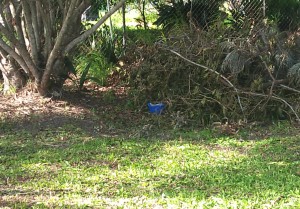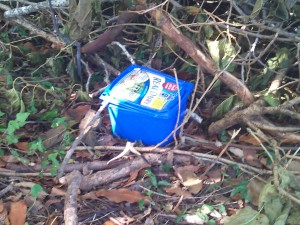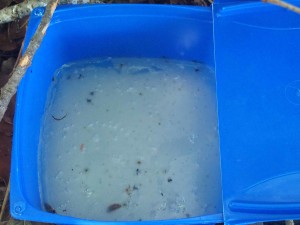I was searching through some of my old files on the computer and came across some notes I had saved from reading about Gil Carandang. I have seen a lot of similar recipes since on eHow but thought it may be of interest to see the writing of this Unconventional Natural Farmer
Lactobacillus bacteria used in Composting
One of the major workhorse beneficial indigenous micro-organism used in natural farming is lactobacillus. This particular beneficial microorganism is often used in composting for stopping foul odors associated with anaerobic decomposition. Lactic acid bacteria thrive and feed on the ammonia released in the decomposition normally associated with foul odors. So if you need to decompose or ferment wastes and stop foul odors, lactic acid bacteria is the specific bacteria to use. Its application in organic farming is enormous.
Lactobacillus used in Aquaculture
In aquaculture, one of the problem is related to water quality. Poor water quality stresses the fish which in turn stunts their growth and affects their health. This is very evident specially in high density and tank aquaculture. The ammonia produced through fish excretions pollute the water and stress the fish. Regular addition of lactobacillus beneficial microorganisms to the water, minimizes the ammonia problem, if not stopping it completely. It helps hasten or complete the denitrification by converting wastes into forms not harmful to fish.
Spraying a diluted solution of lactic acid bacteria serum on to the plant and soil helps plant growth and health. As it is applied to the soil or the leaves, these beneficial bacteria aid in the decomposition process, thus allowing more food to be available and assimilated by the plant.
Lactic acid bacteria is also known to produce enzymes and natural antibiotics aiding effective digestion and has antibacterial properties, including control of salmonella and e. coli. Farmers see an improvement in the general health of the plants and animals, better nutrient assimilation, feed conversion and certain toxins eliminations.
Here’s a simple method of collecting this type of microorganism. Lactic acid bacteria can be collected from the air. Pour rice wash (solution generated when you wash the rice with water) on a container like plastic pot with lid. Allow air gap at least 50-75{cd07be7979728a86b172d4c3c193ee8254293b2598ced4c874c66a7b3dbba444} of the container. The key here is the air space. (use a 2 litre ice cream container)
Cover the (not vacuum tight, allowing air still to move into the container) container with lid loosely. Put the container in a quiet area with no direct sunlight. Allow the rice to ferment for at least 5-7 days. Lactic acid bacteria will gather in 5-7 days when temperature is 20-25 degrees C. Rice bran will be separated and float in the liquid, like a thin film, smelling sour. Strain and simply get the liquid. Put this liquid in a bigger container (use a 4 litre ice cream container) and pour ten parts milk. The original liquid has been infected with different types of microbes including lacto bacilli. And in order to get the pure lacto bacilli, saturation of milk will eliminate the other microorganisms and the pure lacto bacilli will be left. You may use skim or powdered milk, although fresh milk is best. In 5-7 days, carbohydrate, protein and fat will float leaving yellow liquid (serum), which contain the lactic acid bacteria.
You can dispose the coagulated carbohydrate, protein and fat, add them to your compost pile or feed them to your animals. The pure lactic acid bacteria serum can be stored in the refrigerator or simply add equal amount of crude sugar (dilute with 1/3 water) or molasses.
Do not use refined sugar as they are chemically bleached and may affect the lactic acid bacteria. The sugar or molasses will keep the lactic acid bacteria alive at room temperature. One to one ratio is suggested although sugar, regardless of quantity is meant simply, serving as food for the bacteria to keep them alive. Now, these lactic acid bacteria serum with sugar or molasses will be your pure culture.
To use, you can dilute this pure culture with 20 parts water. Make sure water is not chemically treated with, like chlorine. Remember, we are dealing with live microorganisms and chlorine can kill them. This diluted form 1:20 ratio will be your basic lactic acid bacteria concoction. Two to four tablespoons added to water of one gallon can be used as your basic spray and can be added to water and feeds of animals. For bigger animals, the 2-4 tablespoons of this diluted lactic acid bacteria serum should be used without diluting it further with water. Lactic acid bacteria serum can be applied to plant leaves to fortify phyllosphere microbes, to soil and compost. Of course, it will help improve digestion and nutrient assimilation for animals and other applications mentioned before. For any kind of imbalance, be it in the soil or digestive system, lacto bacilli can be of help.
EM Innoculant
One of the popular beneficial microorganism innoculants from Japan (EM) contains lactic acid bacteria as its major component, including photosynthetic bacteria, yeasts, actinomycetes and fermenting fungi. These are pure culture imported from Japan and can be subcultured through the use of sugar or molasses. These other microbes can be cultured in several ways by farmers themselves.
Instructions from Ehow
Prepare a liquid in which to grow the lactobacilli by pouring rice into a bowl and covering it with water. Leave for five minutes, then strain the cloudy water into another bowl.
Cover the bowl with a cloth and secure it with a rubber band, allowing the rice-water to breathe.
Place the bowl in a cool, dark place and leave for one to two weeks. Lactobacilli form more easily in warmer temperatures. At 68 degrees Fahrenheit (20 degrees Celsius) a week is sufficient; at lower temperatures two weeks is best.
Feed the lactobacilli. The rice-water (or other liquid you already have) will have attracted many different kinds of bacteria from the air and the lactobacilli need to be encouraged, so that they will displace the others. Strain the mixture into a larger container to remove any scum or spores. Feed the lactobacilli by adding 10 parts milk to the water.
Cover the mixture again with the cloth, securing with the rubber band. Leave in a cool, dark place for five days to a week.
Skim the mixture. After this time the fats in the milk will have separated to the top and underneath a pure lactobacilli culture will have formed. Skim off the fat, taking care not to mix it with the culture underneath once more.
Preserve the culture. Either place the culture in a refrigerator where it will keep for up to a year (if the mixture smells sour, the lactobacilli are no longer present) or add the same quantity again (one to one ratio) of sugar or molasses to keep the bacteria alive at room temperature. The lactobacillus culture is now ready to use.
I guess the next post will be how to use it and some pictures



